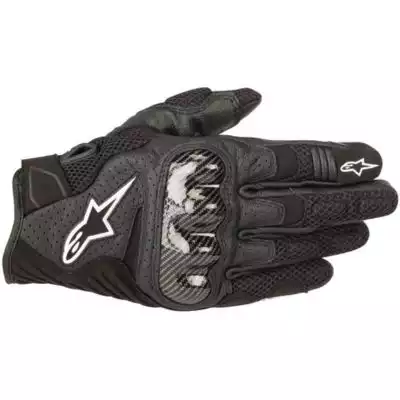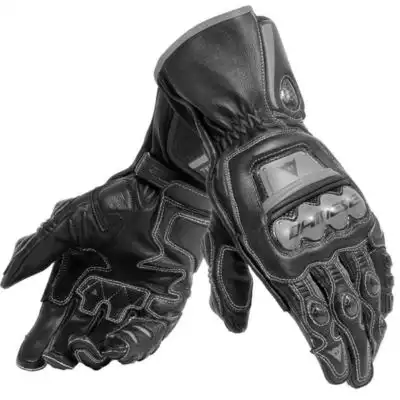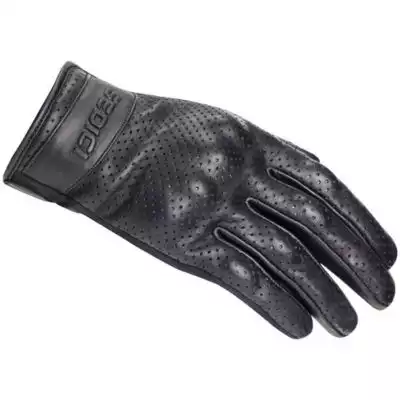Motorcycle gloves are an often overlooked part of your riding gear. However, getting the right pair of gloves can make a world of difference to your riding experience.
There are gloves for riding in the cold, in the heat, in the rain, and there are heated gloves, lightweight gloves, and racing gloves — whatever you need, there’s a pair of gloves out there to suit.
With all that in mind, you can’t just snatch up the first pair you see and jump on your bike. So I’ve broken down all the things you need to think about when buying motorcycle gloves.
Why Motorcycle Gloves Are Important
Motorcycle gloves are a key component of a rider’s kit and are just as important as a helmet, jacket, or boots. Gloves protect your hands in the event of an accident. Particularly in case of a slide, they’ll prevent serious damage to the skin on your hands.
Gloves also elevate your comfort level on a ride. They protect your hands from the elements, whether it be the wind, rain, or sun, and they also prevent your rubber grips from rubbing the palms of your hands, as well as providing extra grip!
Types of Gloves
There are many different types of motorcycle gloves, and, honestly, you’ll probably end up with more than one pair since they can suit different needs at different times and in different circumstances.
- Fingerless gloves: These are mostly popular for summer riders, cruiser riders, and those who would prefer to wear no gloves at all but want at least some protection on the palms of their hands and knuckles.
They’re better than nothing, but if you’re like me — who plays guitar and likes to make stuff — then you value your hands. Fingerless gloves just aren’t for me.
- Short-cuff gloves: These are available in all sorts of styles, from summer, touring, dirt, and even winter gloves.
They come in leather and textile variations, and they can be fully perforated simple leather gloves or lined with a waterproof and thermal membrane in a textile format.
- Gauntlet gloves: Like short-cuff gloves, these also come in a range of styles, but they’re longer, coming further up the arm to cover the wrist. Winter and touring gloves are often gauntlet-style, along with some sports gloves. Read: Best gauntlet gloves for motorcycle.
Once you’ve figured out whether you want a shorter or longer glove, you can start thinking about the different styles and which will meet your needs.
Summer Gloves
Summer gloves are usually a short-style glove constructed from leather, textile, mesh, or a combination.
They still provide a good level of protection but are well ventilated, with either perforation in the leather or the use of mesh. Sometimes, ventilation channels are built into the gloves via the armor.
A great example of a summer glove is the Alpinestars SMX-1 Air v2 Gloves.
Winter Gloves
Winter gloves can come in a short or long gauntlet style and are usually lined with a fleece thermal liner for added warmth. They’re also usually equipped with a waterproof liner to keep you dry as well as warm. They are much thicker than summer gloves due to the added liner/s and can come in either leather or textile.
Heated gloves are a relatively new addition to the market. They offer a great alternative to heated grips and are arguably more effective.
Sports Gloves
Sports-style gloves can come in either a short or long style. They are usually constructed from leather and are the most protective option. The Dainese Full Metal 6 Gloves are a great example of race-style gloves.
Waterproof Gloves
Waterproof gloves are equipped with a waterproof membrane to keep water out and your hands dry.
The only gloves we can confidently state are definitely waterproof are those with a Gore-Tex liner. Gore-Tex is a tried and tested material that is completely waterproof but also breathable.
Gore-Tex gloves will keep you dry but will also allow your hands to breathe. There are few things worse than trying to get gloves off sweaty, hot hands. Gloves with Gore-Tex do tend to be more expensive than other brands, so keep that in mind.
Some manufacturers have their own waterproof membranes, such as Alpinestars D-Dry, which have developed a very good reputation for their waterproof abilities.
It’s also quite common to find a visor wiper on the thumb of waterproof gloves. This is a nice touch to help you keep your visor clear in the wet.
Dirt Gloves
Dirt-bike gloves are super lightweight and made from a thin textile. They’re built to offer supreme control over the bike, as precision with the clutch and other components is key for off-roading.
These kinds of gloves are no good for road riding, though. They are too lightweight and offer little protection, especially in terms of abrasion resistance.
To narrow down your choices, ask yourself some of the following questions:
- What type of riding do I do? Do I ride spiritedly or cruise along?
- What weather do I ride in?
- Do I ride mostly on or off road?
- What is my budget?
The answers to these questions will help you dictate the style of glove you need. It might be that you need more than one pair, for example, if you ride both on and off road on different bikes.
The type of gloves you need will also dictate how protective they are. If you’re a sports-bike rider, then a pair of racing gloves is a good idea because they offer the most protection. But if you’re more of a laid-back weekend cruiser rider, short leather gloves could be just the trick.
Protection
A good pair of motorcycle gloves should provide your hands with adequate protection. Most importantly, they need to protect you in a slide. The material they are constructed of, as well as any finger/knuckle armor on the gloves, is how they protect your hands.
Leather vs Textile
The leather vs textile debate is something that comes up not only with gloves but with motorcycle jackets and trousers too. Leather has always been the favorite for its protective properties, but in recent years, textile has found its stride and can stand side by side with all the best leather gear.
Leather is still the favorite material used for racing-style gloves and is also the number one choice for a retro look.
Textile is often used for winter gloves. When paired with a waterproof membrane, textile gloves are unbeatable protection from cold, wet weather.
You’ll also see textile gloves with mesh sections for increased ventilation, and these are perfect for hot-weather riding.
Whether you go for leather or textile, you just want to make sure that the gloves are fit for purpose. Look for reinforced sections, particularly on the high-impact areas like the palms, and also for double or triple stitching.
Armor
Gloves can only accommodate so much armor, but at a minimum, you should be looking for gloves that offer some hard-knuckle protection.
The Dainese Full Metal 6 gloves feature carbon-fiber inserts at the finger joints, along with mixed-composite carbon and titanium inserts at the knuckles and back of the hands. There are also some thermoplastic inserts on the side of the little finger and palm.
This kind of protection is perfect for high-speed riding and track days, and it’s just the kind of thing you should be looking for in a sports glove.
Other gloves, like Sedici Lucca Gloves, offer a more simple approach with a gel-padded palm and thermoset memory foam knuckle protection. These would be appropriate for everyday road riding where you’re cruising and speed isn’t a priority.
Some gloves have only small amounts of foam at the knuckles as protection. These won’t be very protective against impacts and may only be good for their abrasion resistance.
CE Ratings
As it stands, motorcycle gloves sold in the US do not need to be CE rated. The CE label is applied to products sold in the EEA (European Economic Area) and is essentially a declaration of compliance with the relevant regulations.
For motorcycle gear, the CE label is a sign that the product has been tested and is suitable as personal protective equipment.
While not essential in the US, a CE rating tells you that the gloves you are buying have been tested and at least meet basic standards of protection.
CE ratings come in Level 1 and Level 2, with Level 2 being the highest and most protective and, thus, the most suitable for high speeds.
Finding the Right Fit
Sizing gloves is a bit tricky — it can be a case of trial and error and lots of patience.
Manufacturers each have their own sizing chart and it is important to consult this at first so you know you’re in the right starting place.
A sizing guide will be based on either palm width or palm circumference.
To measure palm width, lay a soft tape on a flat surface, place your palm down, and measure the widest part of your palm (excluding the thumb), do the same for the other hand and go by the larger of the two numbers.
To measure palm circumference, again, use a soft tape on a flat surface, but this time, wrap the tape around the widest part of your palm and take the measurement.
Compare your measurements against the manufacturer’s guide and there you have your starting point.
Gloves need to feel snug all around your hands and fingers. There should be no pinching, binding, or bunching up anywhere. Your fingers should fill out the gloves and reach right to the tips without any loose material.
If gloves are too loose, they could come off in an accident and, therefore, offer no protection. If there is loose material at the end of the finger, it can make the bike’s controls more difficult to manage and this can be problematic and dangerous.
If gloves are too tight, on the other hand, they can be very uncomfortable and cause your hands to swell as they warm up, leading to you feeling fatigued fairly quickly.
Test Them Out
The best way to know if gloves fit you well is by trying them out on your handlebars. If you have ordered online, just sit on your bike and test your controls without going anywhere. If not, some shops have grips you can try the gloves out on.
By feeling them out like this, you will soon know if the gloves are too tight or too loose.
Leather
If you are looking at leather gloves, you need to be cautious of a couple of things.
- Leather needs to be broken in and usually isn’t comfortable from day one. You will need a break-in period to get them comfortable. Don’t be tempted to size up if they are snug, or you’ll end up with gloves that are too big.
- Leather can shrink. If you regularly ride in the hot sun, the sun warms your hands and causes you to sweat, the moisture dries up the leather, and the gloves shrink. This should only happen in really hot weather, but it’s worth being aware of.
American/British vs European Manufacturers
There are some major differences in the way manufacturers produce gloves depending on where they’re based.
American and British manufacturers tend to produce gloves that are wider in the palm and have thicker fingers, whereas European brands tend to have smaller palms and thinner, longer fingers.
This can be an easy way to establish how a glove is going to fit. If you have small hands with short fingers, then an American brand like ICON might be perfect. If you have long, slender hands, something from the Italian Dainese might work best.
Budget
Motorcycle gloves start from as little as $15 and can go up to $200 or more.
The difference in price is caused by a number of factors:
- Materials
- Features: waterproof, thermal liners, visor wiper, etc.
- Brand
- Protective properties
If you are on a budget, you can find some great gloves for under $50.
If you’re prepared to spend a little extra, though, you can find gloves that fill all your needs. For example, Gore-Tex-lined gloves will cost a bit more, as will heated gloves. It’s unlikely you’ll regret investing in a good pair of motorcycle gloves.


